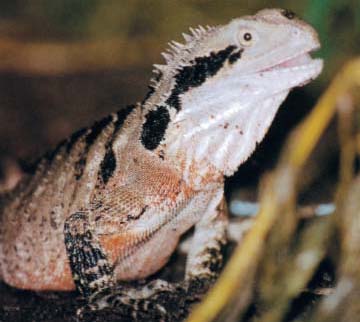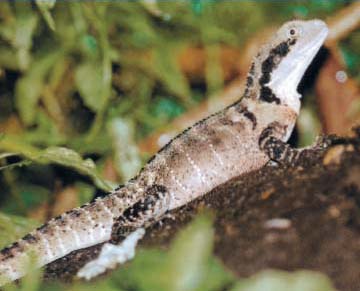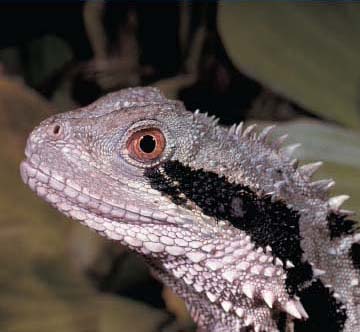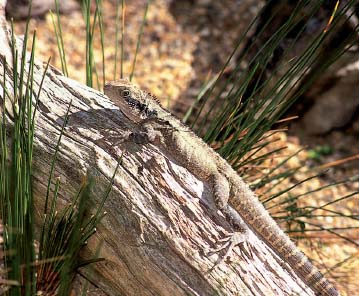CHAPTER 7
LIFE STAGES
Like other animals, green water dragons and other lizards go through developmental stages associated with changes in physiology and behaviors. A simple life stage model developed with reptile experts Susan Donoghue, V.M.D., and Roger Klingenberg, D.V.M., is as follows:
Embyronic
This stage is triggered by the fertilization of an ovum by a sperm and is spent within the confines of an egg. Genetics, the health and diet of adults, incubation temperature, substrate choice, and substrate humidity all impact the health and development of the embryo and its ability to reach the next stage.
Hatchling and Subadult
This stage, characterized by a high growth rate, begins when the water dragon hatches from its egg. At this stage, provide a balanced diet that includes calcium and a source of vitamin D3 to build and maintain the water dragon’s fast growing skeleton. Make sure you do not oversupplement the diet, particularly with vitamin D3.
Hatchlings and juveniles have a larger skin surface area to body volume ratio than adults. As baby water dragons grow, their surface-to-volume ratio will decrease. A consequence of a high relative skin surface is that baby lizards can heat up, cool down, and dehydrate faster than larger ones. In captivity, this means that basking baby lizards can achieve their desired body temperature more quickly and under a lower wattage spotlight than that required for adults. It also means they are at higher risk of overheating if exposed to a hot spotlight or sunlight without access to a cooler shaded area. At this stage, animals also behave differently than adults. Baby lizards typically have a high flight response, which, along with their small size, makes them unsuitable for handling. Their social interactions are mostly passive, although, if raised in groups, faster growing and larger green water dragons may begin intimidating smaller animals. These larger animals are more effective at capturing food, which will help them to further outgrow their cage mates.
Sexual Onset
This stage is triggered by the increased production of sex hormones, the onset of sexual characteristics (such as the enlarged jowls and nuchal crest of males), territorial and sexual behaviors, and the ability to reproduce. Once an animal reaches this stage, the relative growth rate declines, in part because energy is diverted toward reproduction. Nonetheless, a young adult water dragon just beginning to breed will more than double its body weight after reaching this stage. Males, in particular, grow quite a bit larger between sexual onset and adult maturity, a stage characterized by the near absence of growth. At this stage, make sure to provide gravid females with adequate amounts of calcium. During the breeding season, add or design a laying site in the vivarium if you are keeping animals in pairs.
Mature Adult
The defining criterion for this stage is the near cessation of growth. As mature adults, green water dragons have reached their maximum size. Because of their size, females tend to produce large egg clutches but, as they age, their reproductive rate declines.
Old Age
Old water dragons show no signs of growth. Other indicators of old age include reduced activity, reduced feeding, and less frequent rates of shedding. Older females reproduce infrequently or not at all. This stage ends with death.
Australian Water Dragons

The Australian water dragon is a beautiful and hardy species that is now captive bred in moderate numbers. It was first established in U.S. herpetoculture by Bert Langerwerf, the world-famous lizard specialist. To date, this species has had only moderate appeal in the trade, but mostly because adults are seldom available. Although juveniles have nice form and texture, their coloration is rather dull. It is not until sexual maturity that males show their striking characteristics: large heads with high-contrast black and white, and rich red forelimbs and ventral coloration. Some male Australian water dragons rank among the most beautiful large lizards available. This species grows to 3 feet and requires large enclosures with angled perches and plants to provide some visual barrier to observers. They tend to be more wary than green water dragons and somewhat more prone to flight behavior, but they do not tend to damage their snouts.

With regular handling and an enclosure that allows them to witness regular human activity, Australian water dragons make nice pets and display animals. They are more tolerant of cold than most large lizards and will even survive a frost as long as their enclosure allows them to burrow underground. The oldest specimen on record lived for twenty-six years. For successful breeding, decrease temperatures in the winter, with night temperatures in 50s and 60s F. During the cool winter months, Australian water dragons will be inactive for several weeks, remaining hidden in shelters or underground burrows. Apart from the cool winter brumation (hibernation) period, this species should be kept under the same warm conditions as green water dragons. Australian water dragons are not very aggressive and can be kept in groups of males and females in room-sized enclosures. They will breed readily, laying one or two clutches of up to twenty eggs. Their incubation requirements are similar to green water dragons. Generally, Australian water dragons are an under-appreciated species that is slowly gaining popularity.

Australian water dragons have rather dull coloration compared with the bold hues of the green water dragon.

These Australian lizards like plenty of slanted branches in their vivaria to climb on.



